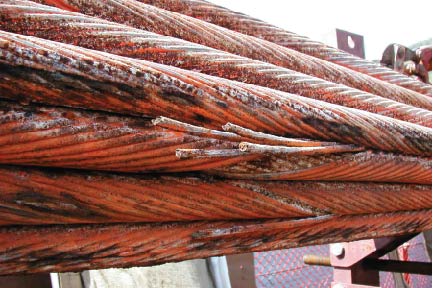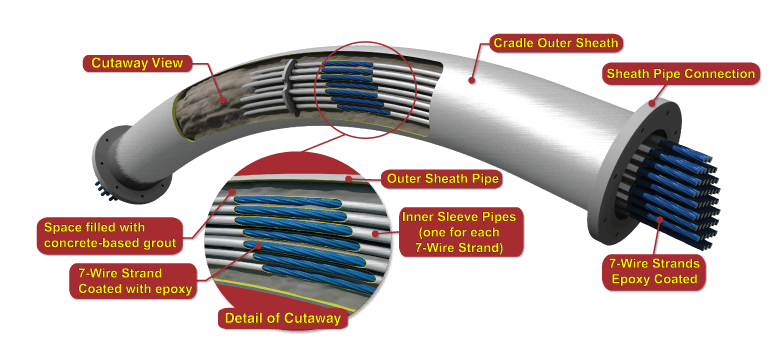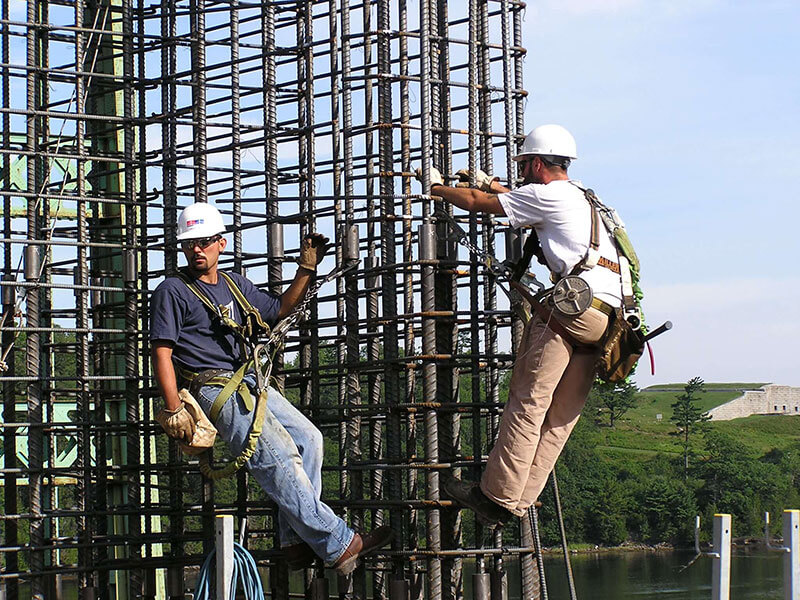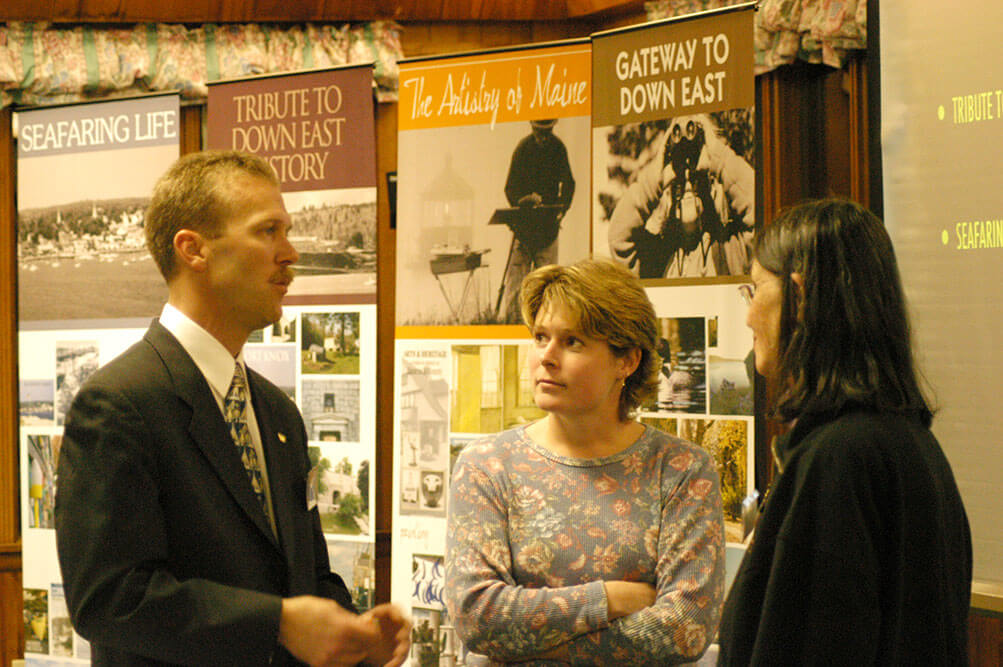Building a Landmark...
The Engineering and Construction of Penobscot Narrows Bridge & Observatory
- Innovative Engineering
- Teamwork
- Community
- Awards
Innovative Engineering

Damaged Cables from the Waldo Hancock Bridge
(Click on image for larger view)

First Cradle of its Type...Detail Cutaway View
(Click on image for larger view)
Since the demise of the Waldo-Hancock Bridge was caused by heavy corrosion of its main cables, protection of the new bridge’s 40 cable stays was a high priority for MaineDOT. Toward that end, three separate techniques were used to ensure proper maintenance and protection.
But first, why did the design team choose a cable-stayed bridge rather than repeating the Waldo-Hancock’s suspension design? Back in 1931, when the Waldo-Hancock Bridge was built, the only way engineers knew how to span a river as wide as the Penobscot was with a suspension bridge. Even today, this technology remains the only way to span very long distances. But in 1955, engineers built the first modern cable-stayed bridge which is now the bridge of choice for medium-length spans. Concrete cable-stayed bridges have several advantages over suspension bridges: they require less cable, can be constructed with identical precast sections and are faster to build. In addition, new techniques make long-term maintenance of the cables much easier and less expensive. Like suspension bridges, cable-stayed bridges are beautiful to behold.
The widest cable-supported bridge in the world is the Leonard P. Zakim Bunker Hill Bridge in Boston. But the Penobscot Narrows Bridge has its own claim to fame: the only public observatory bridge in the United States and the tallest in the world!
Three separate techniques were used to ensure cable maintenance and protection.
- The cables are sheathed in 16 � inch diameter hard-plastic protective tubes.
- Each steel strand is coated with flowfill epoxy where the epoxy fills the spaces inside the strand as well as coating the outside.
- Each plastic tube is filled with an inert gas that allows the internal pressure to be monitored by computer, which will verify that the pipe is not leaking and eliminates all oxygen from the cable-stayed environment.
Further, if the tubing should be compromised, the cable will not corrode because the strand is in a nearly oxygen-free environment. This design also means that individual cables can be easily replaced or upgraded without disturbing traffic or compromising bridge safety.
Teamwork
Most bridge projects of this magnitude take at least a decade to plan and construct because normally a bridge is fully designed before the ground is broken. But the Penobscot Narrows Bridge and Observatory took just 42 months to complete, from concept to opening. The urgency of bringing a new bridge on line in the shortest possible time led the state to initiate a collaborative and innovative process that is called “owner-facilitated design-build.” Though now becoming more common, the design-build method meant that MaineDOT, the designer (Figg Engineering Group), and the prime contractor (Cianbro Corp and Reed & Reed Inc. which joined forces and became a joint venture for this project) worked together to design and build each portion of the bridge sequentially. For example, the foundation was designed and built before the team had finalized plans for the rest of the bridge. This allows for faster decision making and more creativity, without which this unique structure could not have been completed within the targeted timeframe.
This unprecedented partnership – among MaineDOT, Figg Engineering Group and Cianbro/Reed & Reed LLC – rose to the challenge of building an award-winning $85 million bridge in record time.
No one, with even the smallest part in the Penobscot Narrows Bridge and Observatory project, will ever forget the experience.
Community
With the Waldo Hancock posted from 100,000 lbs down to 24,000 lbs, MaineDOT moved quickly to begin the complex job of building a new bridge. Just weeks after the July 1, 2003 kick off, Figg Engineering Group, of Tallahassee Florida was chosen as designer from a group of competitively evaluated RFQs. Meetings with the community began to determine a balance between the best aesthetic for the region, the realities of construction and maintenance costs and the need for an unprecedented delivery time.
Choosing a design for the bridge was a challenge because most new bridges are modern in appearance. But in keeping with local architecture, the community wanted a traditional looking bridge.
During a fall 2003 workshop, the community suggested the new bridge incorporate a “granite” theme to honor the significance this stone has had in the local economy. Granite also reflects the timeless, rugged, no-nonsense nature of Maine and its people. Researching historical shapes, MaineDOT discovered that the Washington Monument was built partially of granite from nearby Mount Waldo. This led to the idea of modeling the main support towers of the new bridge after the Washington Monument’s obelisk shape. And, like the Washington Monument, the new bridge would include an observatory at the top. This structure represents the values of a community that chose to honor the history of the region with a granite themed signature bridge that is sure to be a strong catalyst for economic growth and community pride.
Awards
- 2004 #1 of Top Ten Bridges of the Year: Roads & Bridges Magazine
- 2004 Strive for Excellence Administrator's Award: FHWA
- 2006 Honor Award: Engineering Excellence: ACEC Maine Chapter
- 2006 Popular Science: Best of What's New in Engineering
- 2006: #17 in Top 25 Bridges of all time: Roads & Bridges Magazine
- 2006 PRIDE Award, 1st place in Community Relations: ARTBA
- 2007 Build Maine Award: Highways Category, Associated Constructors of Maine
- 2007 Grand Award, Site/Civil Category: ACI, Eastern Pennsylvania & Delaware Chapter
- 2007: George S. Richardson medal: International Bridge Conference
- 2007 Outstanding Project: National Council of Structural Engineering Association
- 2007 Bridge Award Excellence: American Segmental Bridge Institute
- 2007 Engineering Excellence Award: American Council of Engineering of Colorodo
- 2007 Excellence in Structural Engineering Awards Finalist: NCSEA
- 2007 Globe Award: ARTBA
- 2007 Work Zone Safety Awareness: ARTBA
- 2007 Merit Award, Finalist (1 of 4) Outstanding Civil Engineering Achievement Award: American Society of Civil Engineers
- 2008 Design Award: Concrete Reinforcing Steel Institute
- 2008 Diamond Award: American Council of Engineering Co. of Pennsylvania
- 2008 Engineering Excellence Honor Award: American Council of Engineering Companies
- 2008 Engineering Excellence National Finalist: American Council of Engineering Companies


